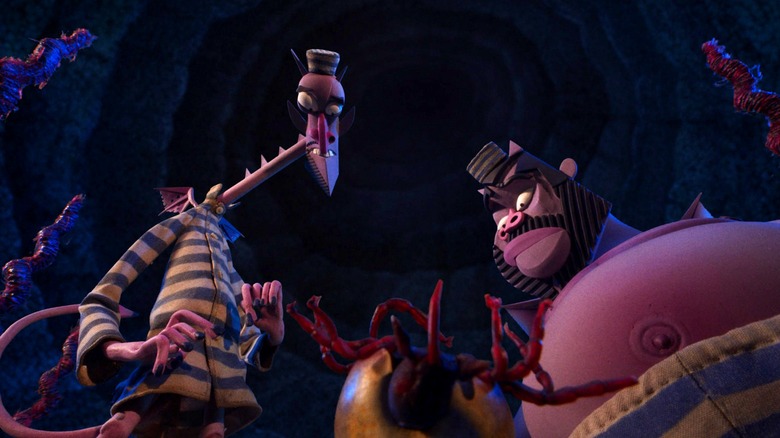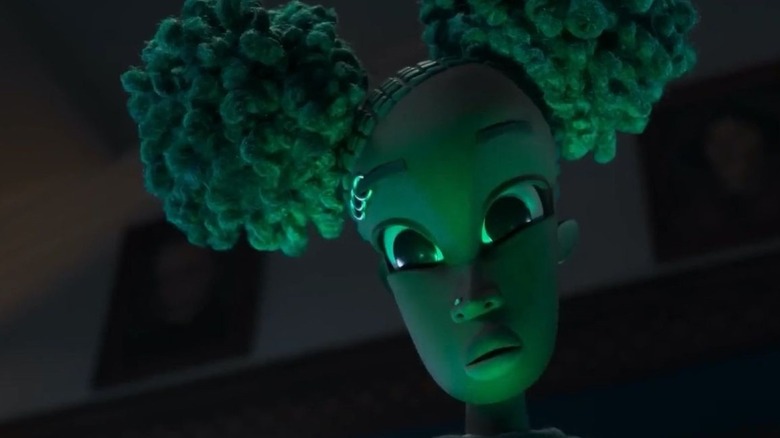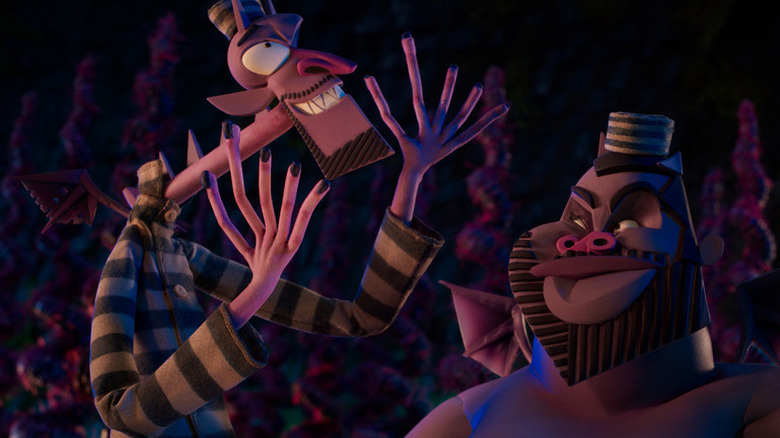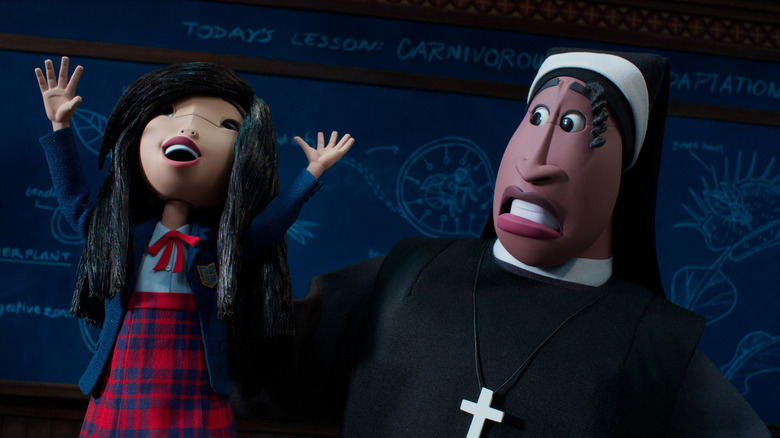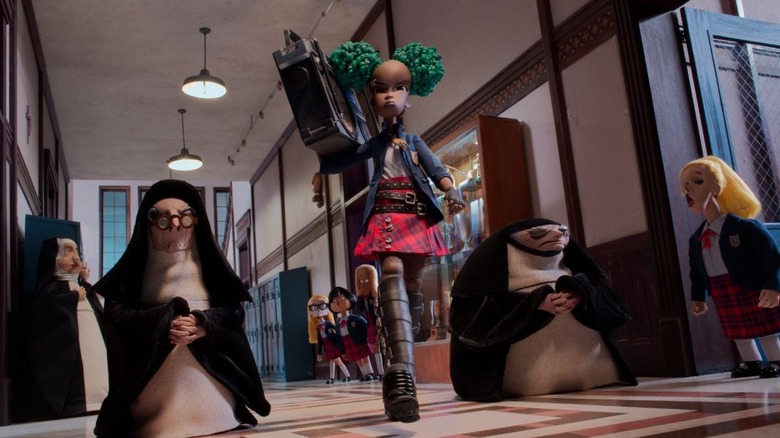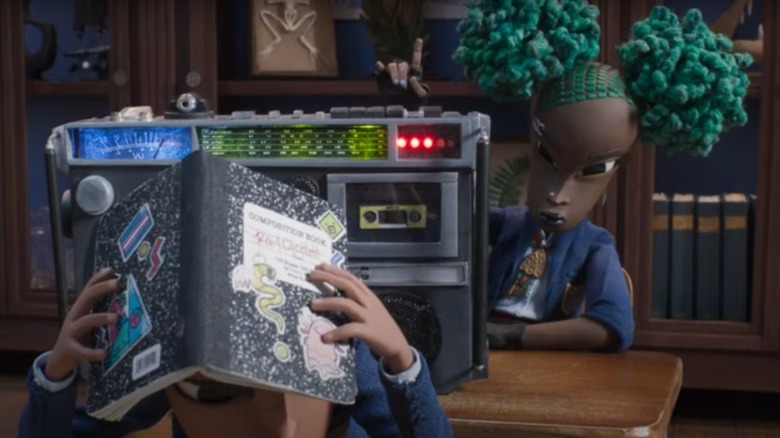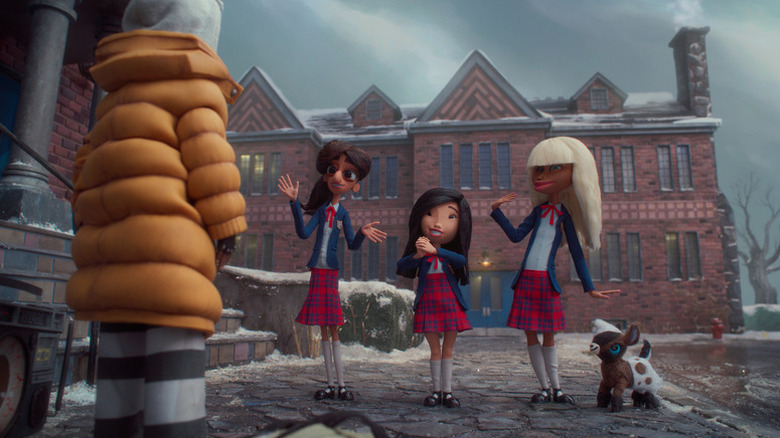Wendell & Wild Director Henry Selick On Its PG-13 Rating And Designing An Amusement Park From Hell [Exclusive Interview]
Henry Selick ("The Nightmare Before Christmas," "Coraline") has made a career out of giving kids nightmares, using the medium of stop-motion animation to create stories that are equal parts magic and entertainment, but also disturbing and strange.
Selick's latest, "Wendell & Wild," offers something both familiar and new. It has the look and the feel of a Selick movie, but with a darker edge to it. Aided by Jordan Peele as a producer and co-writer, "Wendell & Wild" is also funnier than Selick's previous movies and has a biting social commentary. The film follows two demon brothers who enlist a 13-year-old orphan to summon them to our world and get into all sorts of trouble.
Ahead of the film's premiere at the Toronto International Film Festival, /Film spoke with director and co-writer Henry Selick about having characters of color in a stop-motion film, designing an amusement park from hell, what Peele added to the film, and more.
'This is what's right for this story'
It's not very often you see characters of color in an animated film, but the cast of "Wendell & Wild" is very diverse. What led you to that decision?
Right up front, when I first started working with Jordan, he convinced me Kat should be the protagonist because it originally was Sister Helley [a different character, played by Angela Bassett]. He convinced me [it should] be Kat and I said, "Well, I'm a little worried, because I did that film 'Coraline' and I don't want people to think I'm doing the same film." And he said, "Oh no, no one will confuse it with 'Coraline' if she's a person of color — someone that I would've wanted to see in a film when I was a kid."
Once he said that, it was just like, "I want to change all the casting of the film." Even going back to 'Coraline,' there's this character Bobinsky and he performs on the rooftop and I was so tired of all these white people. I just made him blue. Just artistically, I thought, "Oh, it'd be great to have all these different skin tones." And then story-wise, it fell into place and it felt honest, like this is what's right for this story.
I'm curious about the practicality of the puppets, and accurately representing people of color. Particularly in terms of textures and skin tone.
Yeah. I like to go for a really deep dive, and the people that I hire do the same. I had to learn — I didn't know this — but for Kat, someone who has her hair in those big puffs, how does she sleep? Well, we had to research. She has a special scarf she sleeps to hold it in place. It's more interesting to me to find out, "Well, why just make this up?" Start with something that's real, and then you can play with it or exaggerate with it.
It's like that character, Raul. Actually his background would have some Aztec or Mayan blood, so he's familiar with that type of style and art, and that's what he does in the mural that he's painting. He's designing this big mural. So I go on a deep dive to find "What are the treasures that we can bring to these characters, not to overwhelm the audience, but to make them memorable, to make them interesting?" So it's everything. It's the costumes and hair textures, the skin tones. I love to really ripple it all the way through.
'There's a lot of details you'll never even see on that set'
How was it to design the amusement park we see where Wendell and Wild work? It feels like a massive and detailed place we only catch a glimpse of.
You dream very big and you do all this research, but at the end of the day, you've got to make it. And so then you pick, "Well, what are the things that make sense?" And for me, a perfect example is the tea cup ride. The cups that go around. It's something everybody knows from Disneyland. Well, what could we do that makes it a hell version? And so we have hot tea that's poured on people. [laughs] So you're like, "Okay, well, what's the overall feel?" I want it to be run down. I want it to be in very bad shape, breaking or collapsing. Wendell and Wild think they could build something better, and they could. And when you see the whole movie, you'll see what their dream is. But Buffalo Belzer's not going to fix anything. He just wants to keep them screaming through all the waking hours.
But then it comes down to just, "Okay, the feel of it should be that it's rusty. It's worn out." And then it's like, "Well, what rides do we want? What ones make the most sense?" Usually you start with something people know and then you change it. Because if you introduce things that people have no idea what you're showing them, it's hard for them to react. So we went with traditional things: A Ferris wheel, but it dumps people into this tank with electric eels. The teacups, as I said. A swing ride that goes so fast you break and go. And there's a lot of details you'll never even see on that set. We have all these little booths down there and games of chance and so forth, but we couldn't show it all.
'It goes back to my own experience'
Was there a specific ride that you were particularly surprised or proud when you saw it be animated?
I'd say there were no real surprises. The main idea is that it goes back to my own experience where some crazy ride operator turns it up all the way and then doesn't hear the screams as he's torturing the people on the ride. "Help us! Please stop! Please!" For me, that's the main idea, to be trapped in a horrible ride that you can't get off and it could crash and you could die. Of course you're already a soul, so you can't die again. So I'd say the main, not surprise, but the main feeling is that, "Yeah, I think this works, this idea of never-ending bad rides at an amusement park."
I think when the souls drop into the tank and the electric eels bite them and shock them, I think that's actually almost beautiful — the lights and the flashing. So that was a nice surprise, because they put lights inside those eels that could turn on, and it looks really good.
'I never want to do pure horror or slasher'
It seems like scary movies for kids are rarer than in the days of "Coraline" or "The Nightmare Before Christmas." This movie is PG-13 and it does feel a bit edgier than your previous work. How do you find that balance between finding something that's scary for kids while still making it fun?
Well, it might be that people aren't making scary things for those kids. Say, so at eight, 10 to 14 years old, they're not making things for them, but those kids are watching scary things. They're watching older things for older people. So they're exposed — because we have access. So many people have computers and streaming and are watching and they can see — their parents aren't always over their shoulder watching and making them stop. So I feel like I have to compete with, if kids are actually watching things that are meant for older audiences, I think I should also put a little bit of older sense because these kids will want to see that.
I don't want to go there. I never want to do pure horror or slasher. I can't handle that myself. But I do try to just think of where we are now in history and what the audience has already seen. And I felt in this film that they would be ready to be a little heavier, more sadness, but we also have the humor from Key and Peele. But it is a never-ending task to [determine], "Is this tone the right one? Have I gone too far?" And you're always treading this line. There should be scares and powerful things, but I want it to be for brave children of all ages. That's who my audience is.
'We wanted the freedom [a PG-13 rating] gave us'
Was the PG-13 rating part of the initial pitch to Netflix?
Jordan and I felt that when we first set this up, we wanted it to have a PG-13 rating. We wanted the freedom that gave us. We just felt like we wanted to be able to explore some things that most of the regular animated films can't touch by PG-13. And it never meant we wanted to have a lot of violence, a lot of sexuality, a lot of bad language, but we wanted just a little more freedom there. And so we set that up in the deal and it was tricky because the executives who came in are really good people, but they came from DreamWorks to run the animation.
They were shocked that we asked to do a PG-13 rating. So it took a long time of those people, it was getting in tune with each other to find a place that we could work together. Jordan was very good at that. Jordan was especially good at that. I didn't want to hear anything they had to say, but he would listen and say, "No, it'll be okay. We could do this and this. It won't hurt the movie. I promise." And he was always right.
With how long it took to get the movie made, was there anything you wanted to change that you got to rework?
There's certain things that were lost so long ago, I don't miss them and I couldn't put them back now. It wouldn't make sense. But yeah, it took a very long time. And the pandemic was the biggest thing, because we had to shut the studio down. We can't all work at home on our computers and make the movie. We have to be there shooting on sets like live-action. So that had a huge impact in how long it took.
But it's interesting that we set up our deal to make this movie, and after we did that, the animation execs were hired, after we had already did it. And then we had to work with them. Then before we finished, those animation execs were just let go and new ones came in, very near the very end of our film, but they came in with fresh eyes and this one woman, Karen Toliver, she was really good. She showed up just in time to make some great suggestions on music, and then we had a preview screening and we shifted some scenes around. So we outlasted the whole careers of the main animation execs. [laughs]
'I always wanted the villains to be humans'
Can you talk about adding a bit of social commentary to the film with the private prison angle?
There was no initial pushback, but I wanted that in this film — which is fantasy, comedy, horror, and drama — I wanted there to be a couple of connections to real life that are true and powerful. And there's two parts to it. One is I always wanted the villains to be humans. Not the demons, not Buffalo Belzer. I wanted it to be humans. And I kept thinking of, "Well, what could they do that makes them villainous?"
Originally, they were just developers. But then I had done some research and I found there's this whole system here, and it's illegal in some states, but a lot of states where people build their own prisons and then the government pays them so much per prisoner to house them there. And they're known for horrible food, no medical, no rehabilitation. They don't want to let anyone go because it's a steady paycheck. And I felt like, "Yeah, that seems like that could be the start of who the villains are." But on top of that, they're also murderers. You get to see that. So there was that at that end.
Then at the other end, I figure Wendell and Wild are basically prisoners of their own father. They have to work on his hair farm and they wear striped prison things. And they challenged him once. "No, you're going to do this!" Well, I wanted there to be a visual connection to Kat. My wife, she's retired now, but she had this job, a special needs advocate. So she worked with kids. They might have mental disabilities, but they often were kids that were about to be kicked out of school and not allowed back. And those kids all end up in the juvie justice system. They call it the school to prison pipeline.
So she was an expert on that and was always telling me more and more about it. And I talked to Jordan, and he felt like, "Yeah, we can do this. It's not what the movie will be about, but it will be this strong flavor. And let's see." This poor kid, she lost her parents. She's put in these homes. She's bullied. And then you'll find out later in the film exactly what she's done, but she fights back, and there's a thing called zero tolerance. "If you f*** up one time, you're out!" And that's wrong. So I felt on this end, she's stuck in this juvie justice system, and then the other, there are these villains. They'll build a private prison that's ready for these juvies when they graduate from juvie justice. They take them there.
So Jordan, we worked this out and he had a very good idea. He said, "Look, the movie's never going to be about race. We have people of different races and so on, but that's not going to be the conflict." And I agreed, because we didn't want it to be about that and also we didn't want to make this juvie justice and the private — we didn't want to make it about that, but those were strong anchor points. Because we've got this crazy big balloon of a movie, I wanted two points that tethered it to reality.
"Wendell & Wild" will debut at the Toronto International Film Festival on September 11, play in select theaters starting October 21, and arrives on Netflix on October 28, 2022.
